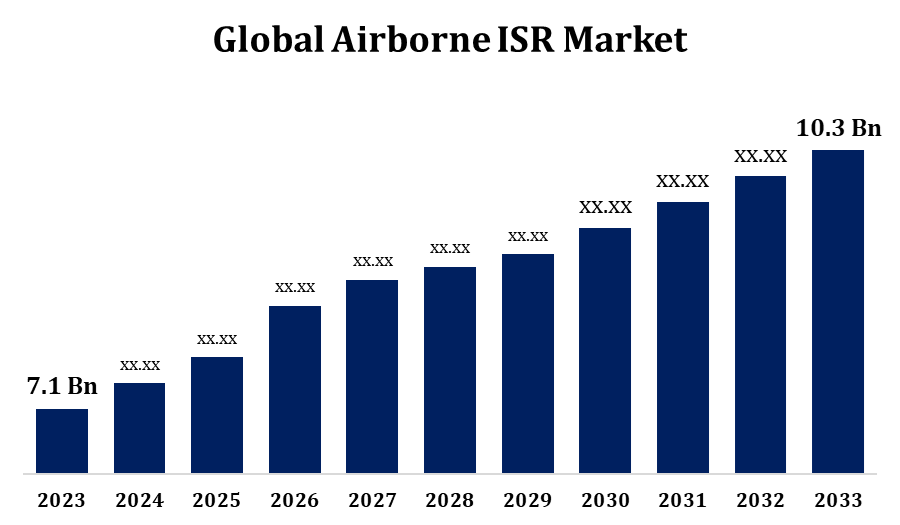Global Airborne ISR Market Size, Share, and COVID-19 Impact Analysis, By Type (Unmanned vehicle and Manned vehicle), By Application (Signals Intelligence, Maritime Patrol, Airborne Ground Surveillance and Airborne Early Warnings), and By Region (North America, Europe, Asia-Pacific, Latin America, Middle East, and Africa), Analysis and Forecast 2023 - 2033
Industry: Aerospace & DefenseGlobal Airborne ISR Market Insights Forecasts to 2033
- The Airborne ISR Market was valued at USD 7.1 billion in 2023.
- The market is growing at a CAGR of 3.79% from 2023 to 2033.
- The global Airborne ISR Market is expected to reach USD 10.3 billion by 2033.
- Asia Pacific is expected to grow the fastest during the forecast period.

Get more details on this report -
The global Airborne ISR Market is expected to reach USD 10.3 billion by 2033, at a CAGR of 3.79% during the forecast period 2023 to 2033.
The global Airborne ISR Market is expected to reach USD 10.3 billion by 2033, at a CAGR of 3.79% during the forecast period 2023 to 2033.
The Airborne ISR market is rapidly expanding, driven by increasing defense needs and technological advancements. Airborne ISR systems, which include unmanned aerial vehicles (UAVs), manned aircraft, and satellite systems, play a vital role in military and civilian operations, offering real-time data collection, surveillance, and reconnaissance. With rising geopolitical tensions and the growing demand for national security, both government and defense sectors are investing in more advanced ISR solutions. Furthermore, the integration of artificial intelligence, machine learning, and data analytics is enhancing the capabilities of airborne ISR platforms. The market is expected to grow due to evolving security challenges, border control needs, and a shift toward remote monitoring, providing significant opportunities for manufacturers and technology developers in this sector.
Airborne ISR Market Value Chain Analysis
The Airborne ISR market value chain involves several key stages, starting with research and development (R&D) where innovations in sensors, UAVs, and communication systems are created. This is followed by the design and manufacturing phase, where specialized components and platforms are assembled. The next stage is system integration, ensuring that the ISR systems are optimized for real-time data gathering, transmission, and analysis. Afterward, these systems are deployed by defense and security agencies for intelligence operations. Maintenance and support services form the final stage, ensuring continuous operation and upgradation of ISR platforms. Throughout the value chain, collaboration between component suppliers, technology providers, and end-users is essential. As the demand for advanced ISR capabilities grows, partnerships between defense contractors and tech firms are crucial for advancing the market’s development.
Airborne ISR Market Opportunity Analysis
The Airborne ISR market presents significant opportunities driven by evolving security threats and technological advancements. Increased defense budgets, particularly in emerging economies, fuel demand for advanced ISR systems to enhance surveillance and intelligence capabilities. The integration of AI, machine learning, and big data analytics into ISR platforms offers opportunities to improve operational efficiency, real-time decision-making, and predictive intelligence. Additionally, the rising need for border security, disaster response, and law enforcement surveillance presents a growing market for airborne ISR in non-military applications. The rapid adoption of UAVs and the shift towards autonomous systems further unlock growth potential. Collaboration between government agencies, defense contractors, and technology firms to develop next-generation ISR solutions represents a major opportunity, driving innovation and enhancing market expansion across both military and civilian sectors.
Global Airborne ISR Market Report Coverage
| Report Coverage | Details |
|---|---|
| Base Year: | 2023 |
| Market Size in 2023: | USD 7.1 billion in 2023. |
| Forecast Period: | 2023 – 2033 |
| Forecast Period CAGR 2023 – 2033 : | 3.79% |
| 023 – 2033 Value Projection: | USD 10.3 billion |
| Historical Data for: | 2019 - 2022 |
| No. of Pages: | 210 |
| Tables, Charts & Figures: | 115 |
| Segments covered: | By Application, By Type and COVID-19 Impact Analysis |
| Companies covered:: | Boeing (U.S.), BAE Systems (U.K.), Elbit Systems Ltd (Israel), FLIR Systems Inc (U.S.), Northrop Grumman (U.S.), General Dynamics (U.S.), Thales (France), Raytheon (U.S.), UTC Aerospace Systems (U.S.), and other key Players |
| Pitfalls & Challenges: | Covid-19 Empact,Challenges,Growth, Analysis. |
Get more details on this report -
Market Dynamics
Airborne ISR Market Dynamics
The demand for airborne ISR equipment is fueled by both national and international instability
The growth of the Airborne ISR market is largely driven by national and international instability, as rising geopolitical tensions and security challenges increase the need for advanced surveillance and intelligence systems. Governments and defense agencies worldwide are investing in airborne ISR equipment to strengthen national security, monitor borders, and address emerging threats such as terrorism and cyber warfare. The versatility of ISR platforms, including UAVs and manned aircraft, makes them invaluable tools for real-time intelligence gathering, reconnaissance, and situational awareness. As conflicts escalate and the demand for enhanced surveillance capabilities grows, the market continues to expand. Additionally, the integration of cutting-edge technologies like artificial intelligence and data analytics further fuels this growth, improving the effectiveness and efficiency of airborne ISR systems in addressing complex security issues.
Restraints & Challenges
One of the primary obstacles is the high cost of developing, deploying, and maintaining advanced ISR systems, which can limit access to these technologies for smaller nations and defense organizations. Additionally, there are concerns regarding data privacy and cybersecurity, as airborne ISR platforms often collect vast amounts of sensitive information that could be vulnerable to hacking or unauthorized access. Operational limitations, such as weather conditions and the endurance of unmanned aerial vehicles (UAVs), also pose challenges to effective ISR deployment. Furthermore, regulatory hurdles, particularly in airspace management and the integration of UAVs into civilian airspace, complicate market expansion.
Regional Forecasts
North America Market Statistics

Get more details on this report -
North America is anticipated to dominate the Airborne ISR Market from 2023 to 2033. The United States, as a global leader in defense technology, plays a pivotal role in the market, with significant investments in airborne ISR platforms such as UAVs, manned aircraft, and satellites. The region's military agencies, including the U.S. Department of Defense, rely heavily on ISR capabilities for national security, counterterrorism, and border control. Additionally, North America's strong technological infrastructure fosters the integration of cutting-edge technologies like AI, machine learning, and data analytics into ISR systems, further enhancing their effectiveness. As geopolitical tensions rise and the need for enhanced intelligence capabilities grows, the North American market for airborne ISR is expected to expand significantly in the coming years.
Asia Pacific Market Statistics
Asia Pacific is witnessing the fastest market growth between 2023 to 2033. China, India, Japan, and South Korea are investing heavily in airborne ISR systems to enhance their military capabilities, improve border security, and monitor regional conflicts. The rising threats from terrorism, piracy, and territorial disputes in the South China Sea further push the demand for advanced surveillance technologies. Additionally, the region’s rapid technological advancements and expanding defense industry foster the development of more sophisticated ISR platforms, including UAVs and satellite systems. The integration of AI, machine learning, and data analytics is also gaining momentum, improving the efficiency and precision of airborne ISR operations. As military modernization continues across Asia-Pacific, the region’s market for airborne ISR is expected to expand significantly.
Segmentation Analysis
Insights by Type
The Unmanned vehicle segment accounted for the largest market share over the forecast period 2023 to 2033. Unmanned aerial vehicles (UAVs) provide a significant advantage over manned aircraft, offering the ability to conduct persistent, real-time intelligence gathering without risking human lives. UAVs are particularly useful for border patrol, maritime surveillance, and monitoring conflict zones. Their ability to operate in harsh or high-risk environments further enhances their appeal for military and security agencies. Additionally, advancements in UAV technology, such as improved battery life, enhanced sensor capabilities, and autonomous operation, are fueling growth in this segment. As nations and defense organizations continue to prioritize cost-effective and versatile ISR solutions, the unmanned vehicle segment is expected to dominate the airborne ISR market in the coming years.
Insights by Application
The Airborne Ground Surveillance segment accounted for the largest market share over the forecast period 2023 to 2033. AGS systems, typically deployed via UAVs or manned aircraft, are essential for monitoring ground activities such as troop movements, border security, and conflict zones. The segment’s growth is driven by the increasing demand for border control, counterinsurgency operations, and disaster management. With advancements in radar and sensor technologies, AGS systems are becoming more capable of detecting and tracking ground targets across vast areas, even in challenging weather conditions. Furthermore, the integration of AI and machine learning for data analysis is enhancing the effectiveness of AGS, making it a vital component in modern surveillance and reconnaissance efforts. As security concerns rise, the AGS segment is poised for continued expansion.
Recent Market Developments
- In October 2021, the 6th Annual Airborne ISR Conference, hosted by SMi, will take place in London on October 20th and 21st, 2021. This event will delve into key topics such as maritime patrol, data dissemination, UAV technology, international surveillance cooperation, AWACS, 5th Generation ISR, industrial engagement, and the evolution of emerging threats.
Competitive Landscape
Major players in the market
- Boeing (U.S.)
- BAE Systems (U.K.)
- Elbit Systems Ltd (Israel)
- FLIR Systems Inc (U.S.)
- Northrop Grumman (U.S.)
- General Dynamics (U.S.)
- Thales (France)
- Raytheon (U.S.)
- UTC Aerospace Systems (U.S.)
Market Segmentation
This study forecasts revenue at global, regional, and country levels from 2023 to 2033.
Airborne ISR Market, Type Analysis
- Unmanned vehicle
- Manned vehicle
Airborne ISR Market, Application Analysis
- Signals Intelligence
- Maritime Patrol
- Airborne Ground Surveillance
- Airborne Early Warnings
Airborne ISR Market, Regional Analysis
- North America
- US
- Canada
- Mexico
- Europe
- Germany
- Uk
- France
- Italy
- Spain
- Russia
- Rest of Europe
- Asia Pacific
- China
- Japan
- India
- South Korea
- Australia
- Rest of Asia Pacific
- South America
- Brazil
- Argentina
- Rest of South America
- Middle East & Africa
- UAE
- Saudi Arabia
- Qatar
- South Africa
- Rest of the Middle East & Africa
Frequently Asked Questions (FAQ)
-
1. What is the market size of the Airborne ISR Market?The global Airborne ISR Market is expected to grow from USD 7.1 billion in 2023 to USD 10.3 billion by 2033, at a CAGR of 3.79% during the forecast period 2023-2033.
-
2. Who are the key market players of the Airborne ISR Market?Some of the key market players of the market are Boeing (U.S.), BAE Systems (U.K.), Elbit Systems Ltd (Israel), FLIR Systems Inc (U.S.), Northrop Grumman (U.S.), General Dynamics (U.S.), Thales (France), Raytheon (U.S.), UTC Aerospace Systems (U.S.).
-
3. Which segment holds the largest market share?The Unmanned vehicle segment holds the largest market share and is going to continue its dominance.
-
4. Which region dominates the Airborne ISR Market?North America dominates the Airborne ISR Market and has the highest market share.
Need help to buy this report?